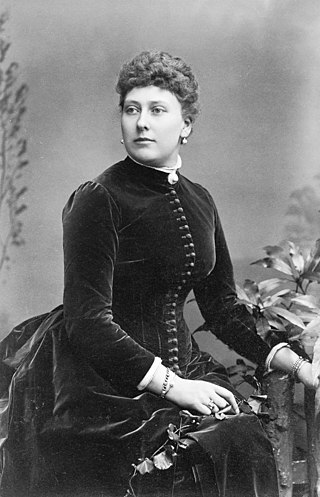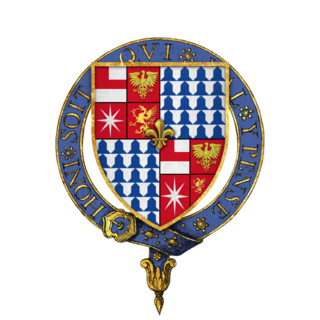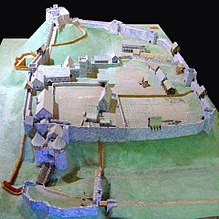
The Isle of Wight is an island, English county and unitary authority in the English Channel, 2 to 5 miles off the coast of Hampshire, across the Solent. It is the largest and second-most populous island in England. Referred to as "The Island" by residents, the Isle of Wight has resorts that have been popular holiday destinations since Victorian times. It is known for its mild climate, coastal scenery, and verdant landscape of fields, downland, and chines. The island is historically part of Hampshire. The island is designated a UNESCO Biosphere Reserve.

Moonfleet is an 1898 novel written by English writer J. Meade Falkner. The plot is an adventure tale of smuggling, treasure, and shipwreck set in 18th-century England.

Princess Beatrice, later Princess Henry of Battenberg, was the fifth daughter and youngest child of Queen Victoria and Prince Albert. Beatrice was also the last of Queen Victoria's children to die, nearly 66 years after the first, her elder sister Alice.

Prince Henry of Battenberg, formerly Count Henry of Battenberg, was a morganatic descendant of the Grand Ducal House of Hesse. He became a member of the British royal family by marriage to Princess Beatrice of the United Kingdom, the youngest child of Queen Victoria. Through his daughter, Victoria Eugenie, who became the queen consort of Spain, Henry is a direct ancestor of current members of the Spanish royal family.

Newport is the county town of the Isle of Wight, an island county off the south coast of England. The town is slightly north of the centre of the island, and is in the civil parish of Newport and Carisbrooke. It has a quay at the head of the navigable section of the River Medina, which flows northwards to Cowes and the Solent. The 2021 census recorded a population of 25,407.

Marquess of Carisbrooke was a title in the Peerage of the United Kingdom. It was created in 1917 for Alexander Mountbatten, eldest son of Princess Beatrice of the United Kingdom and Prince Henry of Battenberg. He was made Viscount Launceston, in the County of Cornwall, and Earl of Berkhamsted at the same time, also in the Peerage of the United Kingdom.

The Isle of Wight is rich in historical and archaeological sites, from prehistoric fossil beds with dinosaur remains, to dwellings and artefacts dating back to the Bronze Age, Iron Age, and Roman periods.

Carisbrooke is a village on the south-western outskirts of Newport, in the civil parish of Newport and Carisbrooke, Isle of Wight, England. It is best known as the site of Carisbrooke Castle. It also has a medieval parish church, St Mary's Church, which began as part of a Benedictine priory established by French monks circa 1150. The priory was dissolved by King Henry V of England in 1415, during the Hundred Years' War. In 1907, the church was restored. It has a 14th-century tower rising in five stages with a turret at one corner and a battlemented and pinnacled crown.
Federigo Giambelli, was an Italian military and civil engineer who worked in Spain, the Spanish Netherlands and England in the late 16th and early 17th centuries.

Thorley is a village and former civil parish, now in the parish of Yarmouth, on the Isle of Wight, England. It is 1+1⁄2 miles (2.4 km) from Yarmouth in the northwest of the island and is 9 miles (14 km) west from Newport. In 1931 the parish had a population of 125.
The Lord of the Isle of Wight was a feudal title, at times hereditary and at others by royal appointment in the Kingdom of England, before the development of an extensive peerage system.

Isabel de Forz was the eldest daughter of Baldwin de Redvers, 6th Earl of Devon (1217–1245). On the death of her brother Baldwin de Redvers, 7th Earl of Devon, in 1262, without children, she inherited suo jure the earldom and also the feudal barony of Plympton in Devon, and the lordship of the Isle of Wight. After the early death of her husband and her brother, before she was thirty years old, she inherited their estates and became one of the richest women in England, living mainly in Carisbrooke Castle on the Isle of Wight, which she held from the king as tenant-in-chief.

The Church of St Nicholas in Castro, Carisbrooke is a parish church in the Church of England located in Carisbrooke, Isle of Wight.

St Mildred's Church, Whippingham is the Church of England parish church of the village of Whippingham, Isle of Wight.

St Olave's Church, Gatcombe is a parish church in the Church of England located in Gatcombe, Isle of Wight. It is grouped with Sts Thomas Minster, Newport, St John's, Newport and St Mary's, Carisbrooke.

Sts Thomas Minster, Newport Minster or The Minster Church of Sts Thomas, until 2008 Sts Thomas Church, is civically recognised as the main Anglican church on the Isle of Wight. Unusually, it is dedicated to both Thomas Becket and Thomas the Apostle.

Carisbrooke Priory was an alien priory, a dependency of Lyre Abbey in Normandy. The priory was situated on rising ground on the outskirts of Carisbrooke close to Newport on the Isle of Wight. This priory was dissolved in around 1415.

Victoria Recreation Ground is a park located on Recreation Ground Road, just off Carisbrooke Road, in Newport, on the Isle of Wight, England. It was opened in 1902.

Sir William Russell (1257–1311) was an English nobleman, knight, and holder of a moiety of the feudal barony of North Cadbury, Somerset, but spent most of his life engaged in the administration and defence of the Isle of Wight, where he obtained by marriage the manor of Yaverland. He served as constable of Carisbrooke Castle, and sat in parliament on two occasions, firstly as burgess for Great Bedwyn, Wiltshire, and then for the County of Southampton. As a baron his military service was called on several times by King Edward I Hammer of the Scots.

Sir Edward Woodville was a member of the Woodville family during the Wars of the Roses. He survived the reign of Richard III in which several of his relatives were executed in a power struggle after the death of his brother-in-law Edward IV. Exiled with Henry Tudor, he participated in Henry's capture of the throne. He was then appointed Lord of the Isle of Wight, the last person to be given that title.


























